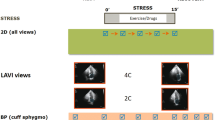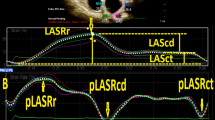Abstract
Cardiac autonomic unbalance is a major determinant of vulnerability to arrhythmias and a risk factor for sudden death. The clinical assessment with baroreflex sensitivity or heart rate variability remains complex, time-consuming, and inaccurate. The sympathetic reserve can be easily assessed with zero training and 100% reproducibility during stress echocardiography through heart rate reserve, calculated from 1-lead ECG present in the echo monitor as the peak-to-rest ratio of heart rate. The normal cutoff values are higher (≥1.80) for stronger chronotropic stresses such as exercise or dobutamine and lower (>1.22) for milder chronotropic stresses such as dipyridamole or adenosine, which stimulate cardiac afferent neurons through A2A adenosine receptors, independently of inducible ischemia and arterial hypotension. A reduced heart rate reserve is a sign of abnormal cardiac sympathetic reserve, an important prognostic factor, and a potential therapeutic target. A reduced heart rate reserve and inducible regional wall motion abnormalities have incremental value in predicting outcomes. Heart rate reserve is imaging-independent and useful to assess the arrhythmic vulnerability and cardiac autonomic unbalance during stress echocardiography.
Access this chapter
Tax calculation will be finalised at checkout
Purchases are for personal use only
Similar content being viewed by others
References
Brubaker PH, Kitzman DW. Chronotropic incompetence. Causes, consequences, and management. Circulation. 2011;123:1010–20.
Fletcher GF, Ades PA, Kligfield P, Arena R, Balady GJ, Bittner VA, et al. American Heart Association exercise, cardiac rehabilitation, and prevention Committee of the Council on clinical cardiology, council on nutrition, physical activity and metabolism, council on cardiovascular and stroke nursing, and council on epidemiology and prevention. Exercise standards for testing and training: a scientific statement from the American Heart Association. Circulation. 2013;128:873–934.
Lauer MS, Francis GS, Okin PM, Pashkow FJ, Snader CE, Marwick TH. Impaired chronotropic response to exercise stress testing as a predictor of mortality. JAMA. 1999;281:524–9.
Hage FG, Iskandrian AE. Heart rate response during vasodilator stress myocardial perfusion imaging: mechanisms and implications. J Nucl Cardiol. 2010;17:536e539.
Fukuda K, Kanazawa H, Aizawa Y, Ardell JL, Shivkumar K. Cardiac innervation, and sudden cardiac death. Circ Res. 2015;116:2005–19.
Laghi-Pasini F, Guideri F, Petersen C, Lazzerini PE, Sicari R, Capecchi PL, et al. Blunted increase in plasma adenosine levels following dipyridamole stress in dilated cardiomyopathy patients. J Intern Med. 2003;254:591–6.
Lucarini AR, Picano E, Marini C, Favilla S, Salvetti A, Distante A. Activation of sympathetic tone during dipyridamole test. Chest. 1992;102:444–7.
Biaggioni I, Killian TJ, Mosqueda-Garcia R, Robertson RM, Robertson D. Adenosine increases sympathetic nerve traffic in humans. Circulation. 1991;83:1668–75.
Petrucci E, Mainardi LT, Balian V, Ghiringhelli S, Bianchi AM, Bertinelli M, et al. Assessment of heart rate variability changes during dipyridamole infusion and dipyridamole-induced myocardial ischemia: a time-variant spectral approach. J Am Coll Cardiol. 1996;28:924–34.
Picano E, De Pieri G, Salerno JA, Arbustini E, Distante A, Martinelli L, et al. Electrocardiographic changes suggestive of myocardial ischemia elicited by dipyridamole infusion in acute rejection early after heart transplantation. Circulation. 1990;81:72–7.
Bombardini T, Pacini D, Potena L, Maccherini M, Kovacevic-Preradovic T, Picano E. Heart rate reserve during dipyridamole stress test applied to potential heart donors in brain death. Minerva Cardioangiol. 2020;68:249–57.
Elhendy A, Mahoney DW, Khanderia BK, Burger K, Pellikka PA. Prognostic significance of impairment of heart rate response to exercise. Impact of left ventricular function and myocardial ischemia. J Am Coll Cardiol. 2003;42:823–30.
Chaowalit N, Mc Cully RB, Callahan MJ, Mookadam F, Bailey KM, Pellikka PA. Outcomes after normal dobutamine SE and predictors of adverse events: long-term follow-up of 3014 patients. Eur Heart J. 2006;27:3039–44.
Cortigiani L, Carpeggiani C, Landi P, Raciti M, Bovenzi F, Picano E. Usefulness of blunted heart rate reserve as an imaging-independent prognostic predictor during dipyridamole-echocardiography test. Am J Cardiol. 2019;124:972–7.
Cortigiani L, Carpeggiani C, Landi P, Raciti M, Bovenzi F, Picano E. Prognostic value of heart rate reserve in patients with permanent atrial fibrillation during dipyridamole SE. Am J Cardiol. 2020;125:1661–5.
Zobel EH, Hasbak P, Winther SA, Hansen CS, Fleischer J, von Scholten BJ. Cardiac autonomic function is associated with myocardial flow reserve in type 1 diabetes. Diabetes. 2019;68:1277–86.
von Scholten BJ, Hansen CS, Hasbak P, Kjaer A, Rossing P, Hansen TW. Cardiac autonomic function is associated with the coronary microcirculatory function in patients with type 2 diabetes. Diabetes. 2016;65:3129–38.
Eleftheriadou A, Williams S, Nevitt S, Brown E, Roylance R, Wilding JPH, et al. The prevalence of cardiac autonomic neuropathy in prediabetes: a systematic review. Diabetologia. 2021;64:288–303.
Ohshima S, Isobe S, Izawa H, Nanasato M, Ando A, Yamada A, et al. Cardiac sympathetic dysfunction correlates with abnormal myocardial contractile reserve in dilated cardiomyopathy patients. J Am Coll Cardiol. 2005;46:2061–8.
Isobe S, Izawa H, Iwase M, Nanasato M, Nonokawa M, Ando A, et al. Cardiac 123I-MIBG reflects left ventricular functional reserve in patients with nonobstructive hypertrophic cardiomyopathy. J Nucl Med. 2005;46:909–16.
Ciampi Q, Olivotto I, Peteiro J, D'Alfonso MG, Mori F, Tassetti L, et al. Prognostic value of reduced heart rate reserve during exercise in hypertrophic cardiomyopathy. J Clin Med. 2021;10:1347.
Cortigiani L, Ciampi Q, Carpeggiani C, Bovenzi F, Picano E. Prognostic value of heart rate reserve is additive to coronary flow velocity reserve during dipyridamole SE. Arch Cardiovasc Dis. 2020;113:244–51.
Cortigiani L, Carpeggiani C, Landi P, Raciti M, Bovenzi F, Picano E. SE 2020 study group of the Italian Society of Echocardiography and Cardiovascular Imaging (SIECVI). Prognostic value of heart rate reserve during dipyridamole SE in patients with abnormal chronotropic response to exercise. Am J Cardiol. 2022;154:106–10.
Cortigiani L, Carpeggiani C, Meola L, Djordjevic-Dikic A, Bovenzi F, Picano E. Reduced sympathetic reserve detectable by heart rate response after dipyridamole in anginal patients with normal coronary arteries. J Clin Med. 2022;11:52.
Cortigiani L, Ciampi Q, Carpeggiani C, Lisi C, Bovenzi F, Picano E. Additional prognostic value of heart rate reserve over the left ventricular contractile reserve and coronary flow velocity reserve in diabetic patients with negative vasodilator SE by regional wall motion criteria. Eur Heart J Cardiovasc Imaging. 2022;23:209–16.
Daros CB, Ciampi Q, Cortigiani L, Gaibazzi N, Rigo F, Wierzbowska-Drabik K, et al. Coronary flow, left ventricular contractile and heart rate reserve in non-ischemic heart failure. J Clin Med. 2021;0:3405.
Ciampi Q, Zagatina A, Cortigiani L, Wierzbowska-Drabik K, Kasprzak JD, Haberka M, et al. Prognostic value of stress echocardiography assessed by the ABCDE protocol. Eur Heart J. 2021;42:3869–78.
Zygmunt A, Stanczyk J. Methods of evaluation of autonomic nervous system function. Arch Med Sci. 2010;6:11–8.
Kusumoto FM, Schoenfeld MH, Barrett C, Edgerton JR, Ellenbogen KA, Gold MR, et al. 2018 ACC/AHA/HRS guideline on the evaluation and management of patients with Bradycardia and Cardiac Conduction Delay: a report of the American College of Cardiology/American Heart Association task force on clinical practice guidelines and the Heart Rhythm Society. Circulation. 2019;140:e382–482. Erratum in: Circulation 2019;140:e506–e508.
Lancellotti P, Pellikka PA, Budts W, Chaudhry FA, Donal E, Dulgheru R, et al. The clinical use of stress echocardiography in non-ischaemic heart disease: recommendations from the European Association of Cardiovascular Imaging and the American Society of Echocardiography. Eur Heart J Cardiovasc Imaging. 2016;17:1191–229.
Picano E, Pierard L, Peteiro J, Djordjevic-Dikic A, Sade LE, Cortigiani L, et al. The clinical use of stress echocardiography in chronic coronary syndromes and beyond coronary artery disease: a clinical consensus statement from the European Association of Cardiovascular Imaging of the European Society of Cardiology. Eur heart J Cardiovasc. Imaging. 2023.
Author information
Authors and Affiliations
Editor information
Editors and Affiliations
1 Electronic Supplementary Material
(MP4 3919 kb)
(MP4 4271 kb)
Rights and permissions
Copyright information
© 2023 The Author(s), under exclusive license to Springer Nature Switzerland AG
About this chapter
Cite this chapter
Cortigiani, L., Picano, E. (2023). Step E for EKG-Based Heart Rate Reserve in Stress Echocardiography. In: Picano, E. (eds) Stress Echocardiography. Springer, Cham. https://doi.org/10.1007/978-3-031-31062-1_5
Download citation
DOI: https://doi.org/10.1007/978-3-031-31062-1_5
Published:
Publisher Name: Springer, Cham
Print ISBN: 978-3-031-31061-4
Online ISBN: 978-3-031-31062-1
eBook Packages: MedicineMedicine (R0)




